Charles E W Bean, Diaries, AWM38 3DRL 606/227/1 - Folder - Part 19
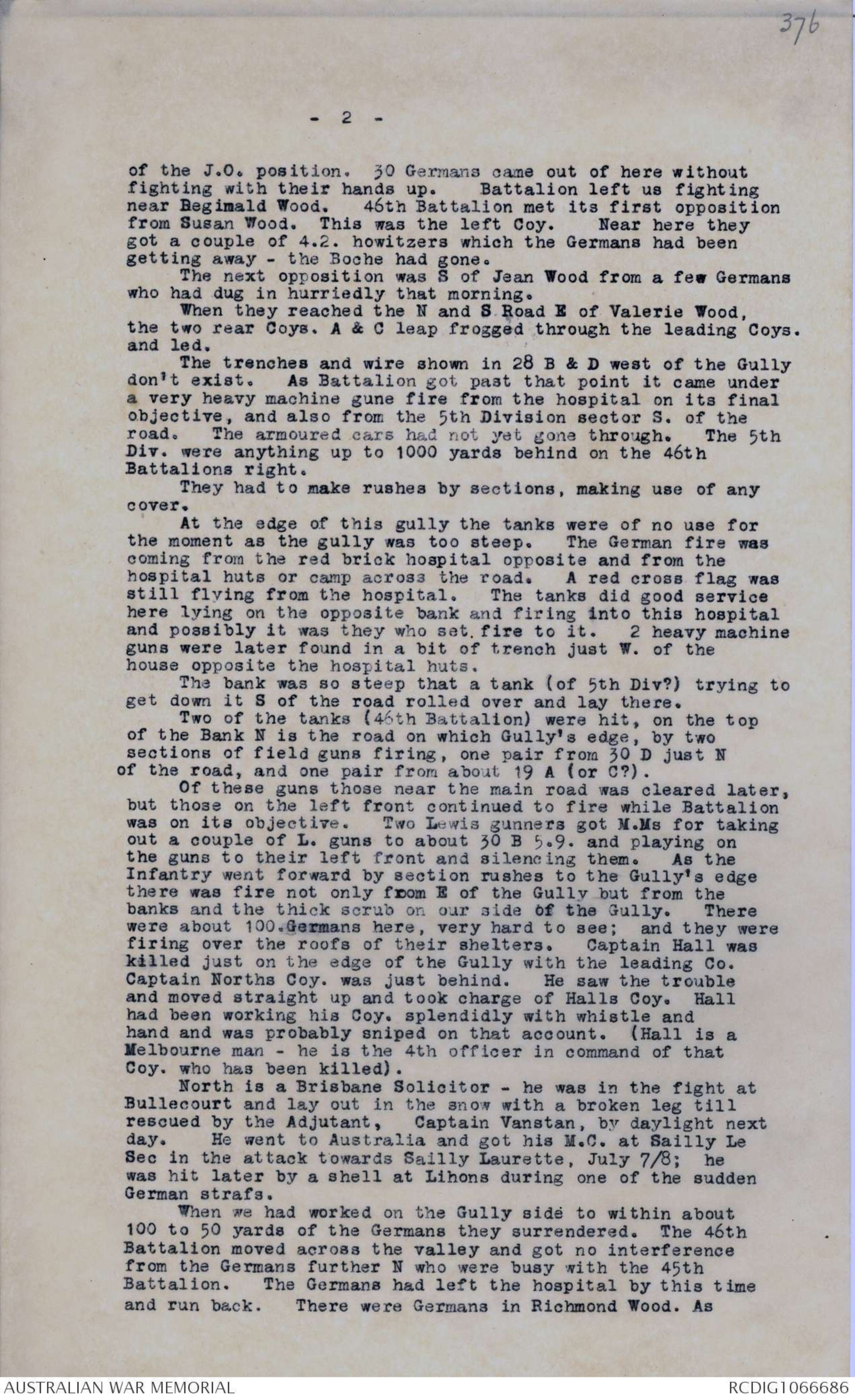
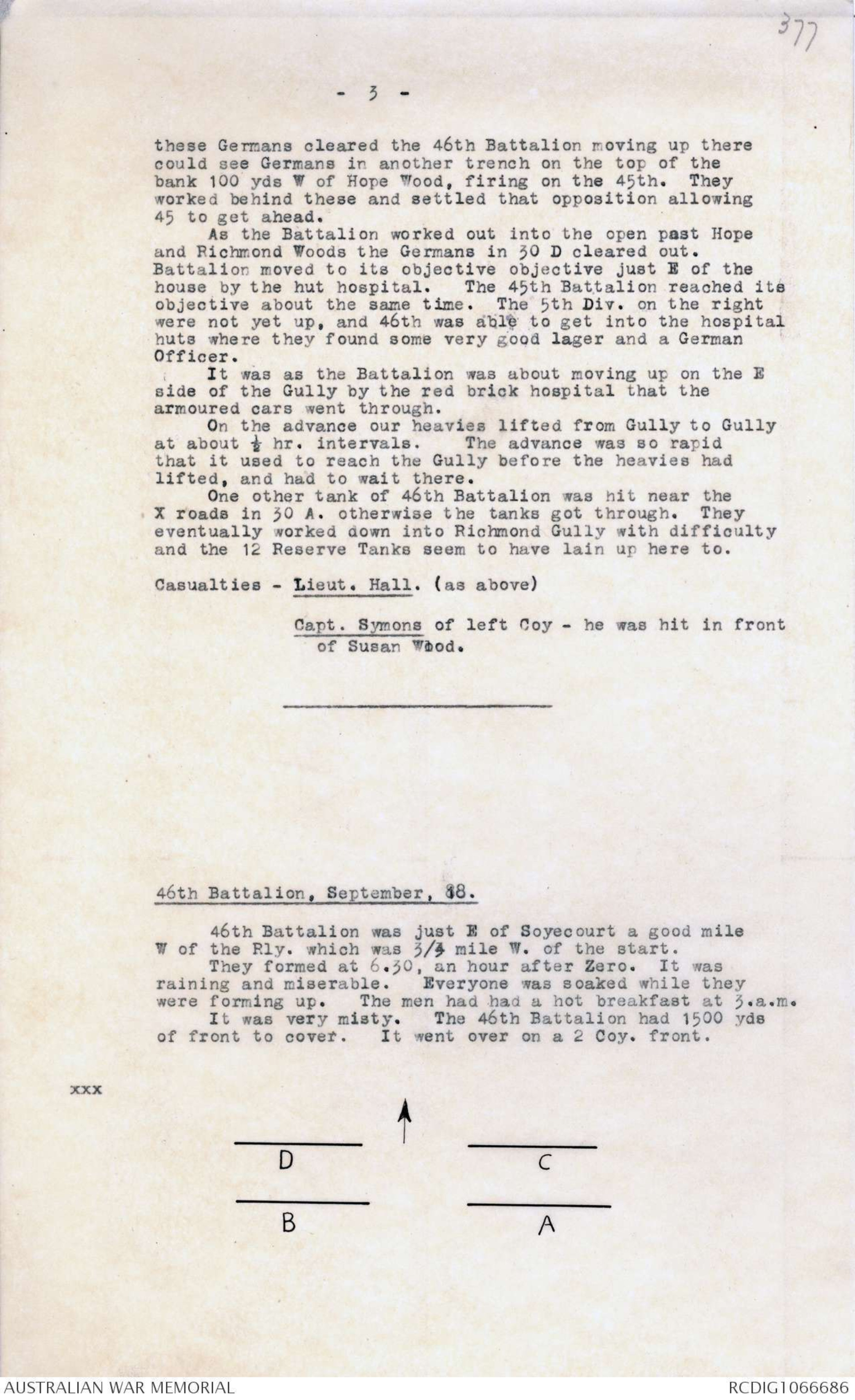
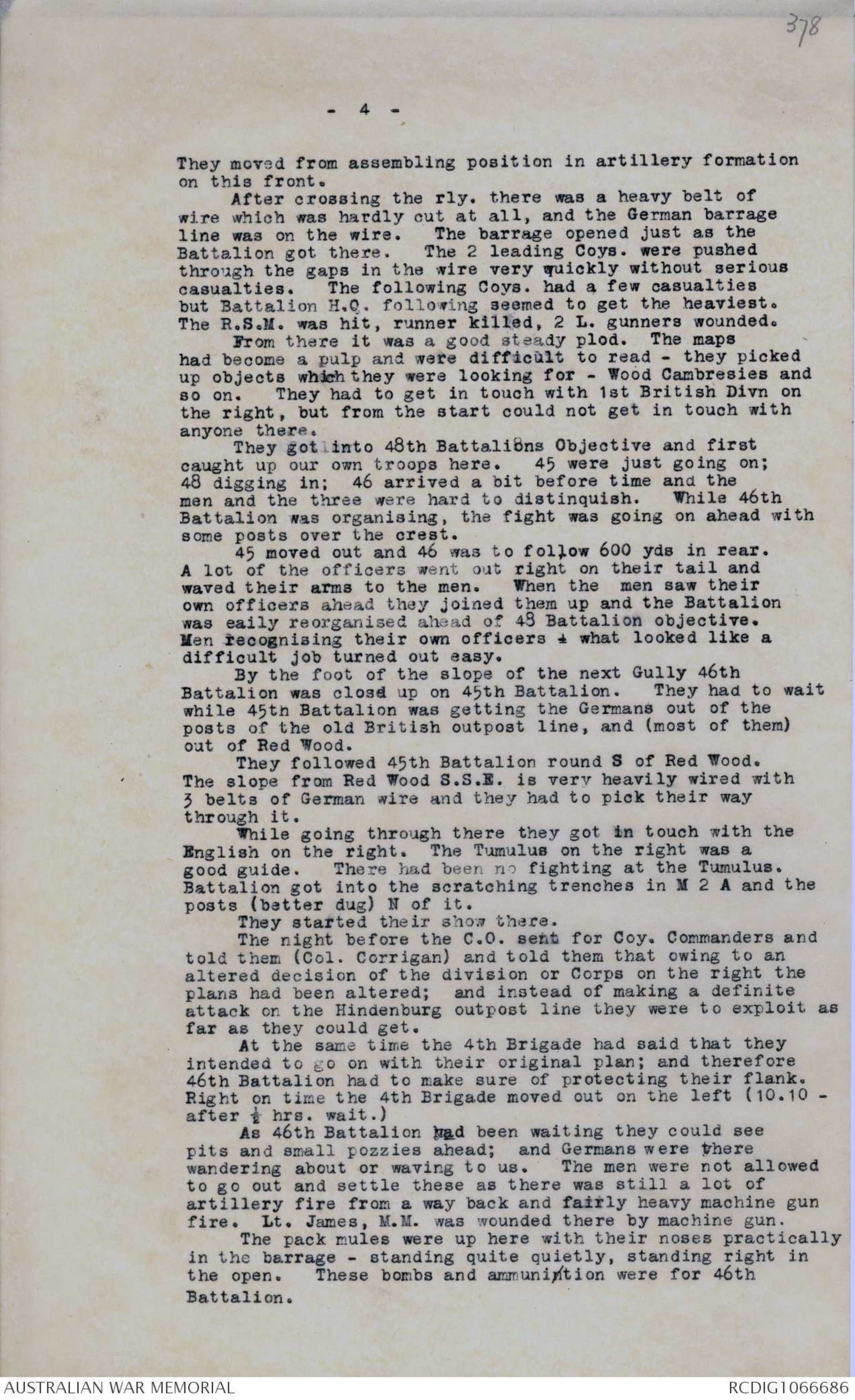
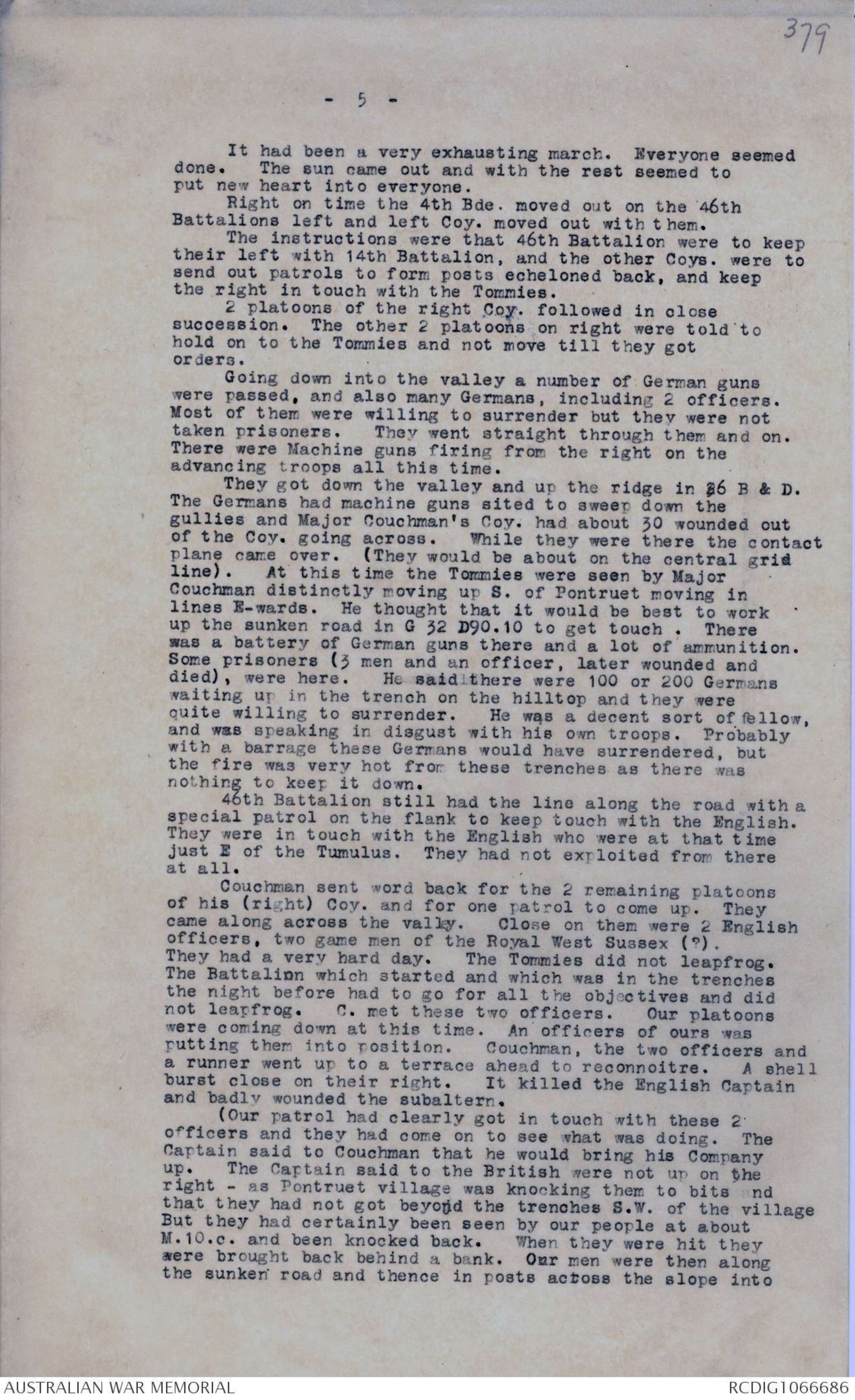
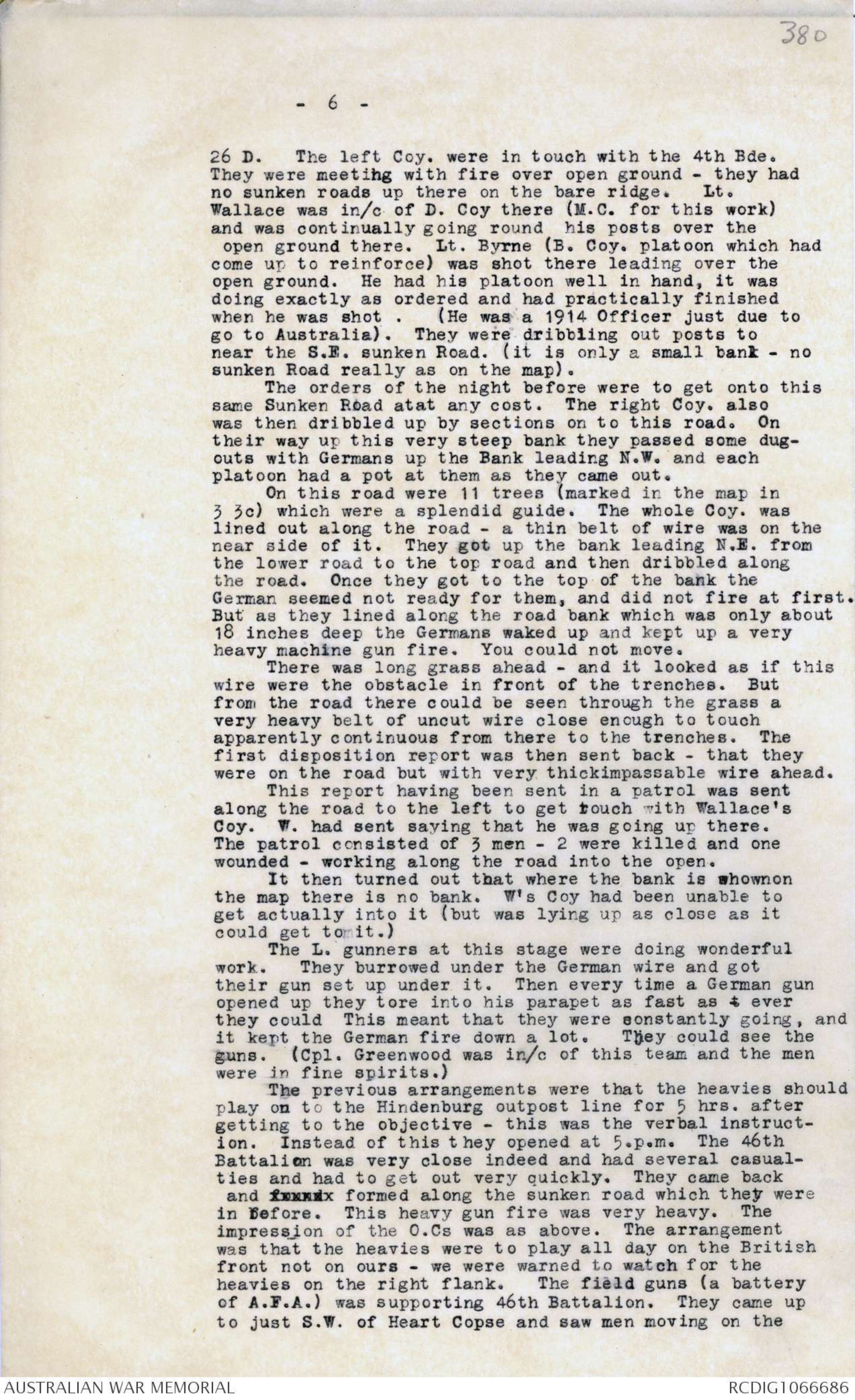
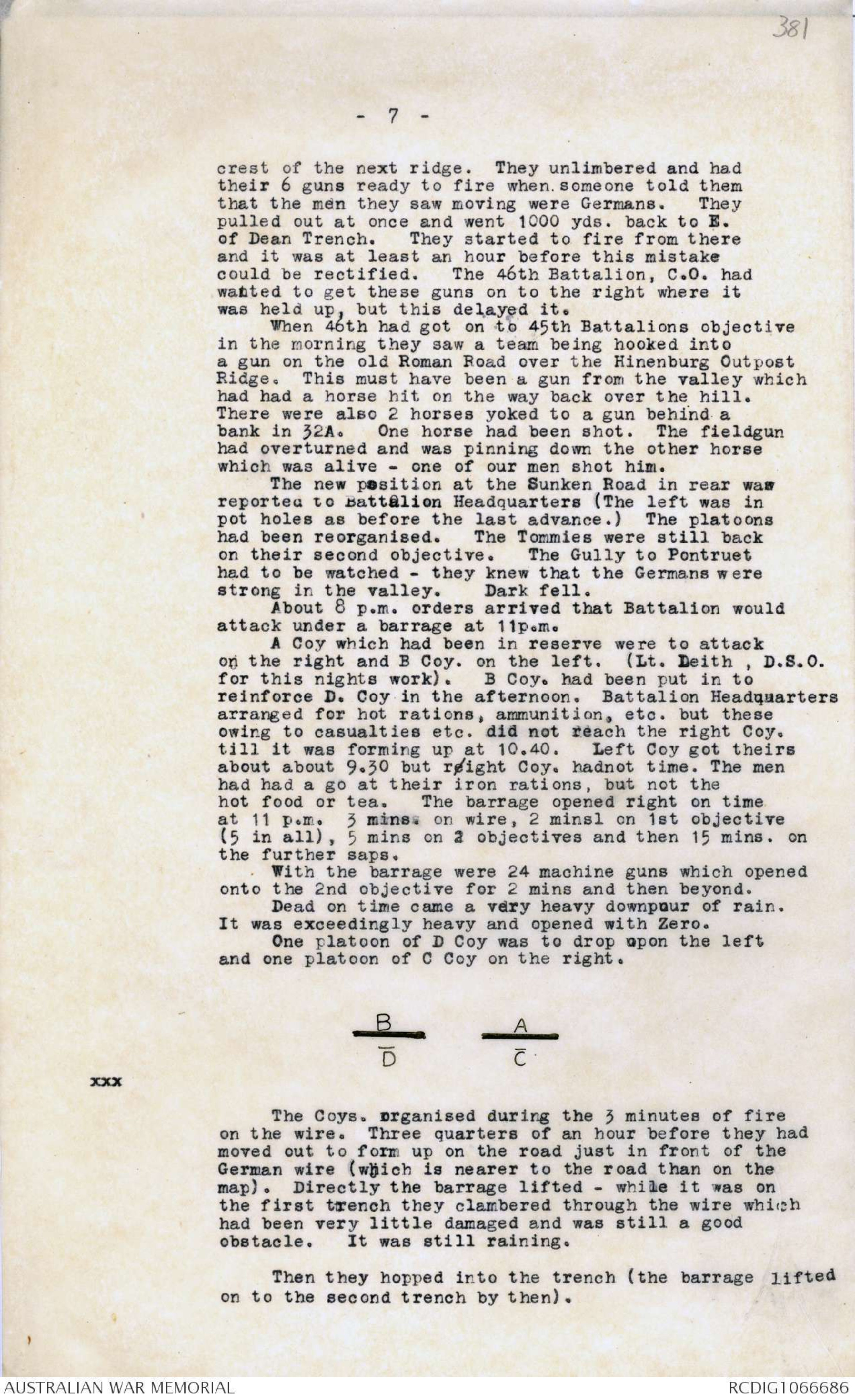
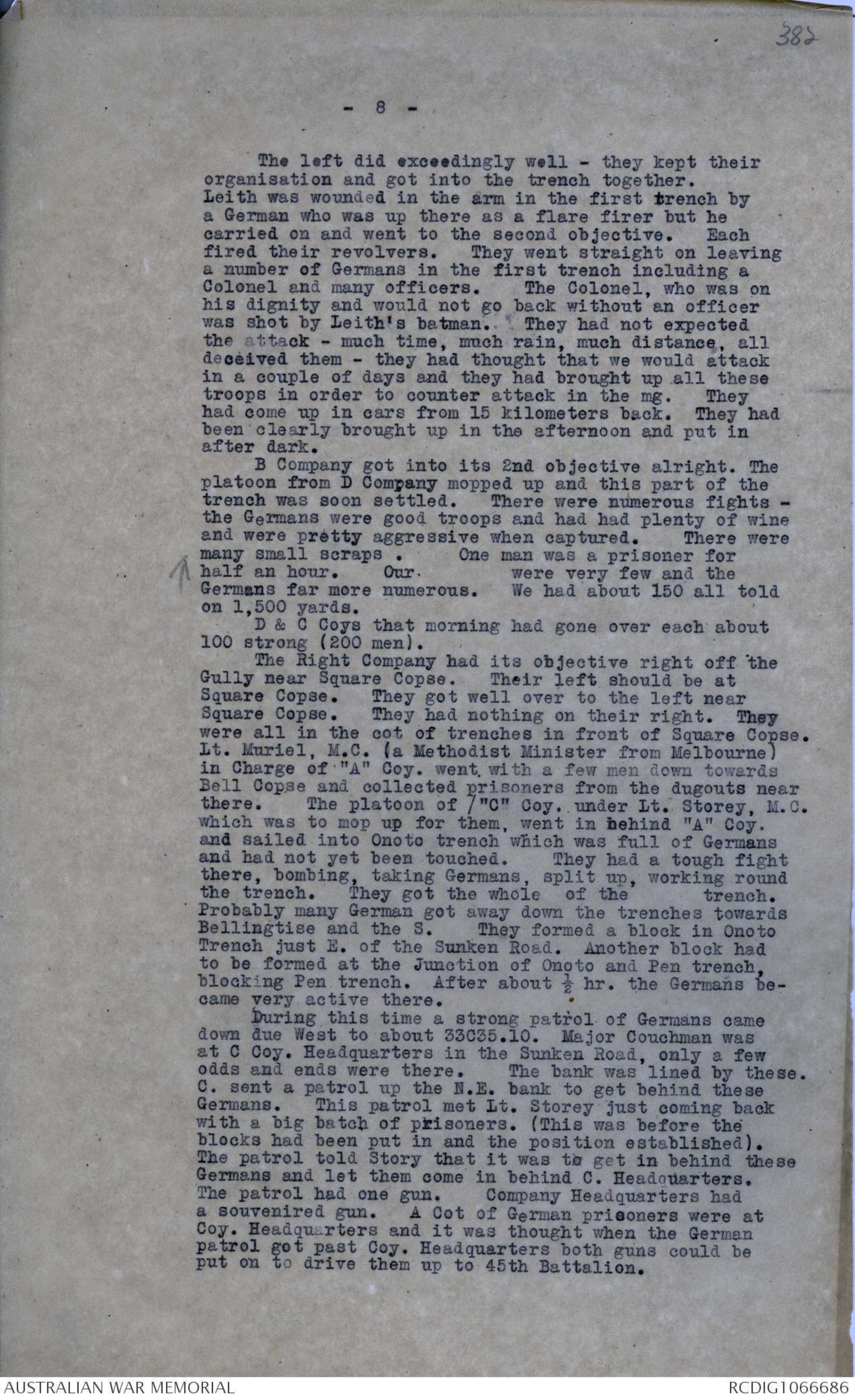
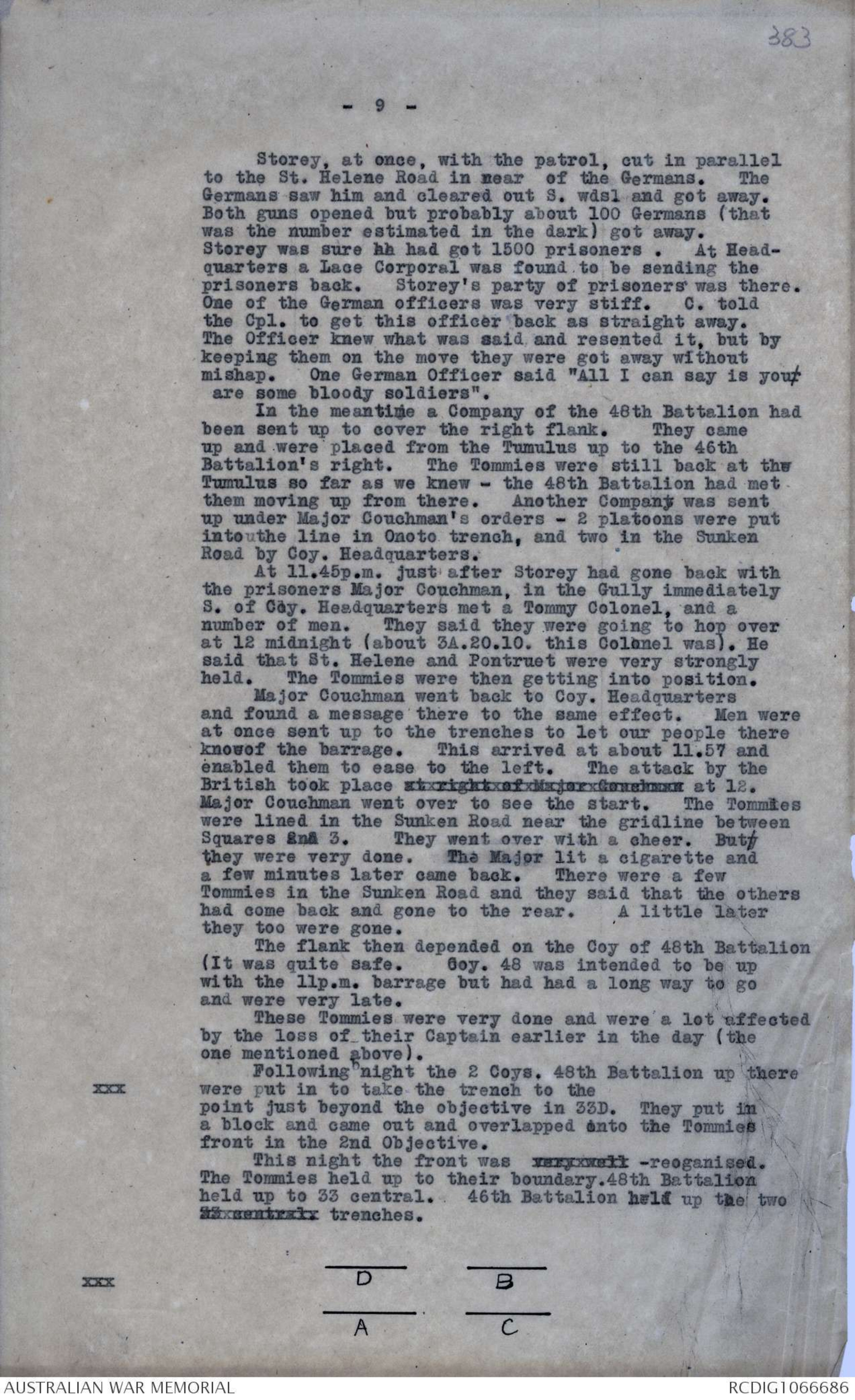
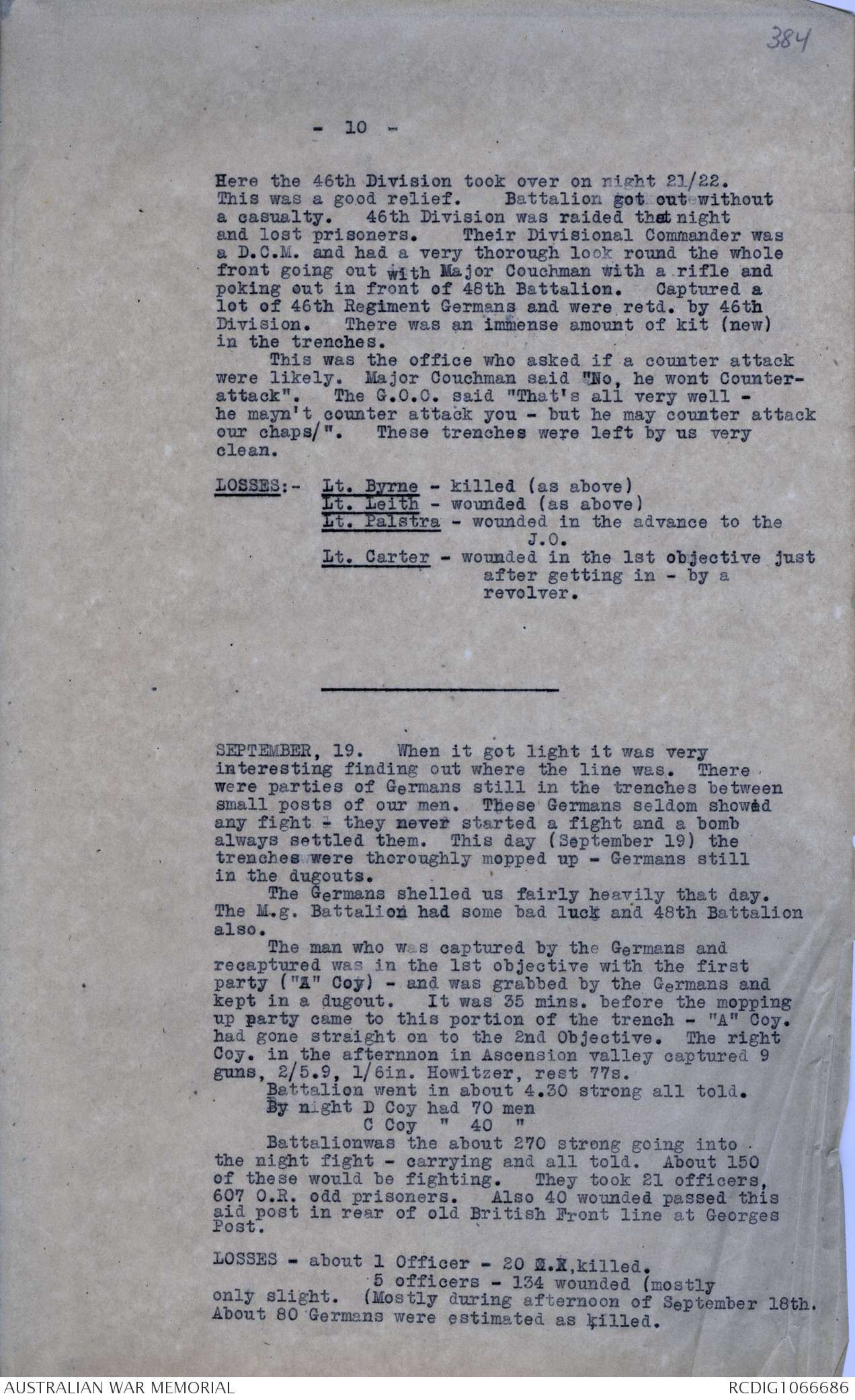
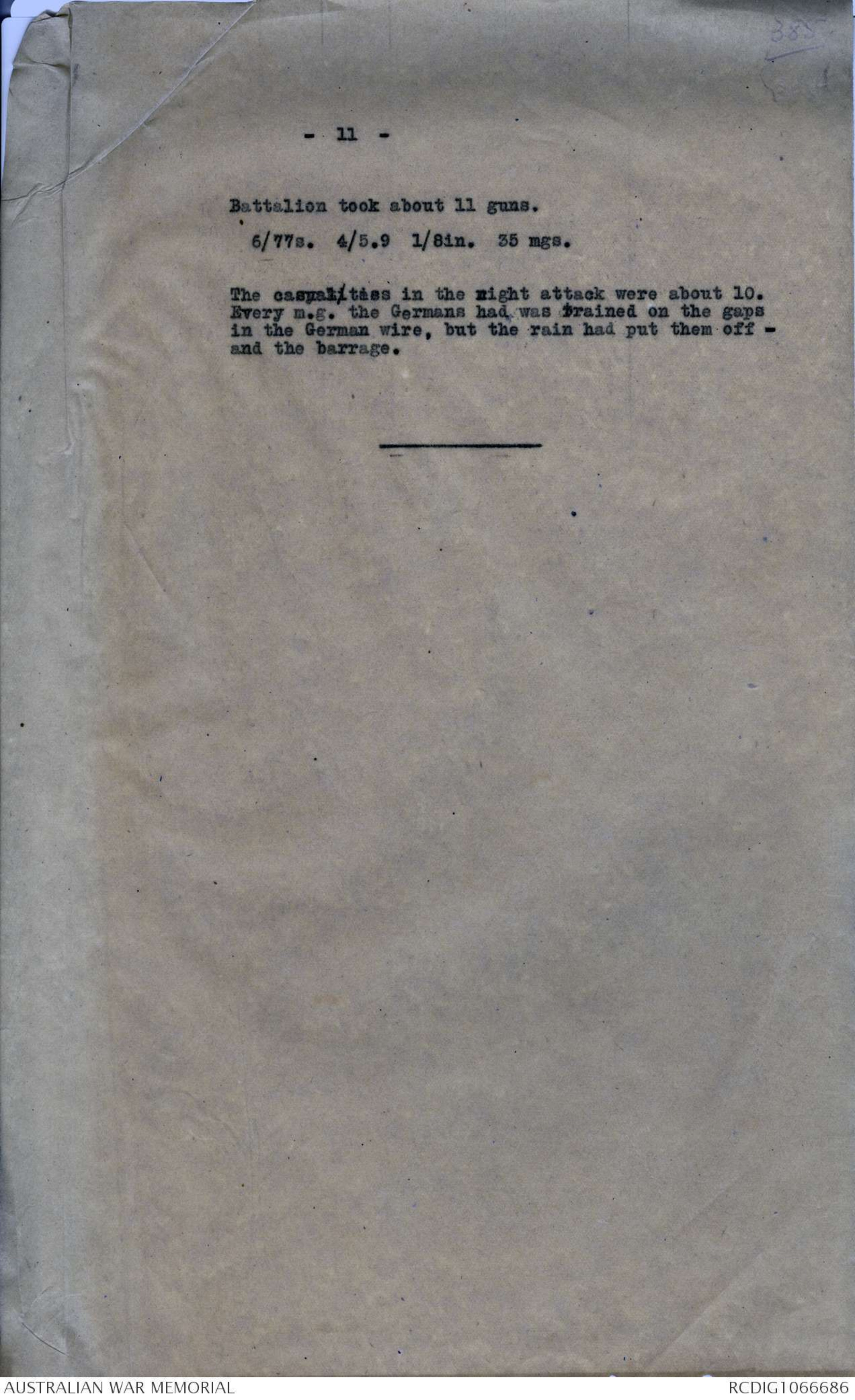
376
- 2 -
of the J.O. position. 30 Germans came out of here without
fighting with their hands up. Battalion left us fighting
near Reginald Wood. This was the left Coy. Near here they
got a couple of 4.2. howitzers which the Germans had been
getting away - the Boche had gone.
The next opposition was S of Jean Wood from a few Germans
who had dug in hurriedly that morning.
When they reached the N and S Road E of Valerie Wood,
the two rear Coys. A & C leap frogged through the leading Coys.
and led.
The trenches and wire shown in 28 B & D west of the Gully
don't exist. As Battalion got past that point it came under
a very heavy machine gune fire from the hospital on its final
objective, and also from the 5th Division sector S. of the
road. The armoured cars had not yet gone through. The 5th
Div. were anything up to 1000 yards behind on the 46th
Battalions right.
They had to make rushes by sections, making use of any
cover.
At the edge of this gully the tanks were of no use for
the moment as the gully was too steep. The German fire was
coming from the red brick hospital opposite and from the
hospital huts or camp across the road. A red cross flag was
still flying from the hospital. The tanks did good service
here lying on the opposite bank and firing into this hospital
and possibly it was they who set fire to it. 2 heavy machine
guns were later found in a bit of trench just W. of the
house opposite the hospital huts.
The bank was so steep that a tank (of 5th Div?) trying to
get down it S of the road rolled over and lay there.
Two of the tanks (46th Battalion) were hit, on the top
of the Bank N is the road on which Gully's edge, by two
sections of field guns firing, one pair from 30 D just N
of the road, and one pair from about 19 A (or C?)
Of these guns those near the main road was cleared later,
but those on the left front continued to fire while Battalion
was on its objective. Two Lewis gunners got M.Ms for taking
out a couple of L. guns to about 30 B 5.9. and playing on
the guns to their left front and silencing them. As the
Infantry went forward by section rushes to the Gully's edge
there was fire not only from E of the Gully but from the
banks and the thick scrub on our side of the Gully. There
were about 100.Germans here, very hard to see; and they were
firing over the roofs of their shelters. Captain Hall was
killed just on the edge of the Gully with the leading Co.
Captain Norths Coy, was just behind. He saw the trouble
and moved straight up and took charge of Halls Coy. Hall
had been working his Coy, splendidly with whistle and
hand and was probably sniped on that account. (Hall is a
Melbourne man - he is the 4th officer in command of that
Coy. who has been killed).
North is a Brisbane Solicitor - he was in the fight at Bullecourt
and lay out in the snow with a broken leg till
rescued by the Adjutant, Captain Vanstan, by daylight next
day. He went to Australia and got his M.C. at Sailly Le
Sec in the attack towards Sailly Laurette, July 7/8; he
was hit later by a shell at Lihons during one of the sudden
German strafs.
When we had worked on the Gully side to within about
100 to 50 yards of the Germans they surrendered. The 46th
Battalion moved across the valley and got no interference
from the Germans further N who were busy with the 45th
Battalion. The Germans had left the hospital by this time
and run back. There were Germans in Richmond Wood. As
377
- 3 -
these Germans cleared the 46th Battalion moving up there
could see Germans in another trench on the top of the
bank 100 yds W of Hope Wood, firing on the 45th. They
worked behind these and settled that opposition allowing
45 to get ahead.
As the Battalion worked out into the open past Hope
and Richmond Woods the Germans in 30 D cleared out.
Battalion moved to its objective objective just E of the
house by the hut hospital. The 45th Battalion reached its
objective about the same time. The 5th Div. on the right
were not yet up, and 46th was able to get into the hospital
huts where they found some very good lager and a German
Officer.
It was as the Battalion was about moving up on the E
side of the Gully by the red brick hospital that the
armoured cars went through.
On the advance our heavies lifted from Gully to Gully
at about ½ hr. intervals. The advance was so rapid
that it used to reach the Gully before the heavies had
lifted, and had to wait there.
One other tank of 46th Battalion was hit near the
X roads in 30 A. otherwise the tanks got through. They
eventually worked down into Richmond Gully with difficulty
and the 12 Reserve Tanks seem to have lain up here to.
Casualties - Lieut. Hall. (as above)
Capt. Symons of left Coy - he was hit in front
of Susan Wood.
______________________
46th Battalion, September, 48.
46th Battalion was just E of Soyecourt a good mile
W of the Rly. which was 3/4 mile W. of the start.
They formed at 6.30, an hour after Zero. It was
raining and miserable. Everyone was soaked while they
were forming up. The men had had a hot breakfast at 3.a.m.
It was very misty. The 46th Battalion had 1500 yds
of front to cover. It went over on a 2 Coy. front.
xxx
diagram - see original document
378
- 4 -
They moved from assembling position in artillery formation
on this front.
After crossing the rly. there was a heavy belt of
wire which was hardly cut at all, and the German barrage
line was on the wire. The barrage opened just as the
Battalion got there. The 2 leading Coys. were pushed
through the gaps in the wire very quickly without serious
casualties. The following Coys, had a few casualties
but Battalion H.Q. following seemed to get the heaviest.
The R.S.M. was hit, runner killed, 2 L. gunners wounded.
From there it was a good steady plod. The maps
had become a pulp and were difficult to read - they picked
up objects which they were looking for - Wood Cambresies and
so on. They had to get in touch with 1st British Divn on
the right, but from the start could not get in touch with
anyone there.
They got into 48th Battalions Objective and first
caught up our own troops here. 45 were just going on;
48 digging in: 46 arrived a bit before time and the
men and the three were hard to distinquish. While 46th
Battalion was organising, the fight was going on ahead with
some posts over the crest.
45 moved out and 46 was to follow 600 yds in rear.
A lot of the officers went out right on their tail and
waved their arms to the men. When the men saw their
own officers ahead they joined them up and the Battalion
was eaily reorganised ahead of 48 Battalion objective.
Men recognising their own officers - what looked like a
difficult job turned out easy.
By the foot of the slope of the next Gully 46th
Battalion was close up on 45th Battalion. They had to wait
while 45th Battalion was getting the Germans out of the
posts of the old British outpost line, and (most of them)
out of Red Wood.
They followed 45th Battalion round S of Red Wood.
The slope from Red Wood S.S.E. is very heavily wired with
3 belts of German wire and they had to pick their way
through it.
While going through there they got in touch with the
English on the right. The Tumulus on the right was a
good guide. There had been no fighting at the Tumulus.
Battalion got into the scratching trenches in M 2 A and the
posts (better dug) N of it.
They started their show there.
The night before the C.O. sent for Coy. Commanders and
told them (Col. Corrigan) and told them that owing to an
altered decision of the division or Corps on the right the
plans had been altered; and instead of making a definite
attack on the Hindenburg outpost line they were to exploit as
far as they could get.
At the same time the 4th Brigade had said that they
intended to go on with their original plan; and therefore
46th Battalion had to make sure of protecting their flank.
Right on time the 4th Brigade moved out on the left (10.10 -
after ½ hrs. wait.)
As 46th Battalion had been waiting they could see
pits and small pozzies ahead; and Germans were there
wandering about or waving to us. The men were not allowed
to go out and settle these as there was still a lot of
artillery fire from a way back and fairly heavy machine gun
fire. Lt. James, M.M. was wounded there by machine gun.
The pack mules were up here with their noses practically
in the barrage - standing quite quietly, standing right in
the open. These bombs and ammunintion were for 46th
Battalion.
379
- 5 -
It had been a very exhausting march. Everyone seemed
done. The sun came out and with the rest seemed to
put new heart into everyone.
Right on time the 4th Bde, moved out on the 46th
Battalions left and left Coy. moved out with them.
The instructions were that 46th Battalion were to keep
their left with 14th Battalion, and the other Coys, were to
send out patrols to form posts echeloned back, and keep
the right in touch with the Tommies.
2 platoons of the right Coy. followed in close
succession. The other 2 platoons on right were told to
hold on to the Tommies and not move till they got
orders.
Going down into the valley a number of German guns
were passed, and also many Germans, including 2 officers.
Most of them were willing to surrender but they were not
taken prisoners. They went straight through them and on.
There were Machine guns firing from the right on the
advancing troops all this time.
They got down the valley and up the ridge in 36 B & D.
The Germans had machine guns sited to sweep down the
gullies and Major Couchman's Coy. had about 30 wounded out
of the Coy. going across. While they were there the contact
plane came over. (They would be about on the central grid
line). At this time the Tommies were seen by Major
Couchman distinctly moving up S. of Pontruet moving in
lines E-wards. He thought that it would be best to work
up the sunken road in G 32 D90.10 to get touch. There
was a battery of German guns there and a lot of ammunition.
Some prisoners (3 men and an officer, later wounded and
died), were here. He said there were 100 or 200 Germans
waiting up in the trench on the hilltop and they were
quite willing to surrender. He was a decent sort of fellow,
and was speaking in disgust with his own troops. Probably
with a barrage these Germans would have surrendered, but
the fire was very hot from these trenches as there was
nothing to keep it down.
46th Battalion still had the line along the road with a
special patrol on the flank to keep touch with the English.
They were in touch with the English who were at that time
just E of the Tumulus. They had not exploited from there
at all.
Couchman sent word back for the 2 remaining platoons
of his (right) Coy. and for one patrol to come up. They
came along across the valley. Close on them were 2 English
officers, two game men of the Royal West Sussex (?).
They had a very hard day. The Tommies did not leapfrog.
The Battalion which started and which was in the trenches
the night before had to go for all the objectives and did
not leapfrog. C. met these two officers. Our platoons
were coming down at this time. An officers of ours was
putting them into position. Couchman, the two officers and
a runner went up to a terrace ahead to reconnoitre. A shell
burst close on their right. It killed the English Captain
and badly wounded the subaltern.
Our patrol had clearly got in touch with these 2
officers and they had come on to see what was doing. The
Captain said to Couchman that he would bring his Company
up. The Captain said to the British were not up on the
right - as Pontruet village was knocking them to bits and
that they had not got beyond the trenches S.W. of the village.
But they had certainly been seen by our people at about
M.10.c. and been knocked back. When they were hit they
were brought back behind a bank. Our men were then along
the sunken road and thence in posts across the slope into
380
- 6 -
26 D. The left Coy. were in touch with the 4th Bde.
They were meeting with fire over open ground - they had
no sunken roads up there on the bare ridge. Lt.
Wallace was in/c of D. Coy there (M.C. for this work)
and was continually going round his posts over the
open ground there. Lt. Byrne (B. Coy. platoon which had
come up to reinforce) was shot there leading over the
open ground. He had his platoon well in hand, it was
doing exactly as ordered and had practically finished
when he was shot. (He was a 1914 Officer just due to
go to Australia). They were dribbling out posts to
near the S.E. sunken Road. (it is only a small bank - no
sunken Road really as on the map).
The orders of the night before were to get onto this
same Sunken Road atat any cost. The right Coy. also
was then dribbled up by sections on to this road. On
their way up this very steep bank they passed some dug-
outs with Germans up the Bank leading N.W. and each
platoon had a pot at them as they came out.
On this road were 11 trees (marked in the map in
3 3c) which were a splendid guide. The whole Coy, was
lined out along the road - a thin belt of wire was on the
near side of it. They got up the bank leading N.E. from
the lower road to the top road and then dribbled along
the road. Once they got to the top of the bank the
German seemed not ready for them, and did not fire at first.
But as they lined along the road bank which was only about
18 inches deep the Germans waked up and kept up a very
heavy machine gun fire. You could not move.
There was long grass ahead - and it looked as if this
wire were the obstacle in front of the trenches. But
from the road there could be seen through the grass a
very heavy belt of uncut wire close enough to touch
apparently continuous from there to the trenches. The
first disposition report was then sent back - that they
were on the road but with very thickimpassable wire ahead.
This report having been sent in a patrol was sent
along the road to the left to get touch with Wallace's
Coy. W. had sent saying that he was going up there.
The patrol consisted of 3 men - 2 were killed and one
wounded - working along the road into the open.
It then turned out that where the bank is shown on
the map there is no bank. W's Coy had been unable to
get actually into it (but was lying up as close as it
could get to it.)
The L. gunners at this stage were doing wonderful
work. They burrowed under the German wire and got
their gun set up under it. Then every time a German gun
opened up they tore into his parapet as fast as t ever
they could This meant that they were constantly going, and
it kept the German fire down a lot. They could see the
guns. (Cpl. Greenwood was in/c of this team and the men
were in fine spirits.)
The previous arrangements were that the heavies should
play on to the Hindenburg outpost line for 5 hrs. after
getting to the objective - this was the verbal
instruction. Instead of this they opened at 5.p.m. The 46th
Battalion was very close indeed and had several
casualties and had to get out very quickly. They came back
and found formed along the sunken road which they were
in before. This heavy gun fire was very heavy. The
impression of the O.Cs was as above. The arrangement
was that the heavies were to play all day on the British
front not on ours - we were warned to watch for the
heavies on the right flank. The field guns (a battery
of A.F.A.) was supporting 46th Battalion. They came up
to just S.W. of Heart Copse and saw men moving on the
381
- 7 -
crest of the next ridge. They unlimbered and had
their 6 guns ready to fire when someone told them
that the men they saw moving were Germans. They
pulled out at once and went 1000 yds. back to E.
of Dean Trench. They started to fire from there
and it was at least an hour before this mistake
could be rectified. The 46th Battalion, C.O. had
wanted to get these guns on to the right where it
was held up, but this delayed it.
When 46th had got on to 45th Battalions objective
in the morning they saw a team being hooked into
a gun on the old Roman Road over the Hinenburg Outpost
Ridge. This must have been a gun from the valley which
had had a horse hit on the way back over the hill.
There were also 2 horses yoked to a gun behind a
bank in 32A. One horse had been shot. The fieldgun
had overturned and was pinning down the other horse
which was alive - one of our men shot him.
The new position at the Sunken Road in rear was
reported to Battalion Headquarters (The left was in
pot holes as before the last advance.) The platoons
had been reorganised. The Tommies were still back
on their second objective. The Gully to Pontruet
had to be watched - they knew that the Germans were
strong in the valley. Dark fell.
About 8 p.m. orders arrived that Battalion would
attack under a barrage at 11p.m.
A Coy which had been in reserve were to attack
on the right and B Coy. on the left. (Lt. Deith, D.S.O.
for this nights work). B Coy. had been put in to
reinforce D. Coy in the afternoon. Battalion Headquarters
arranged for hot rations, ammunition, etc. but these
owing to casualties etc. did not reach the right Coy.
till it was forming up at 10.40. Left Coy got theirs
about about 9.30 but reight Coy, hadnot time. The men
had had a go at their iron rations, but not the
hot food or tea. The barrage opened right on time
at 11 p.m. 3 mines on wire, 2 minsl on 1st objective
(5 in all), 5 mins on 2 objectives and then 15 mins. on
the further saps.
With the barrage were 24 machine guns which opened
onto the 2nd objective for 2 mins and then beyond.
Dead on time came a very heavy downpour of rain.
It was exceedingly heavy and opened with Zero.
One platoon of D Coy was to drop upon the left
and one platoon of C Coy on the right.
diagram - see original document
xxx
The Coys. organised during the 3 minutes of fire
on the wire. Three quarters of an hour before they had
moved out to form up on the road just in front of the
German wire (which is nearer to the road than on the
map). Directly the barrage lifted - while it was on
the first trench they clambered through the wire which
had been very little damaged and was still a good
obstacle. It was still raining.
Then they hopped into the trench (the barrage lifted on to the second trench by then).
382
- 8 -
The left did exceedingly well - they kept their
organisation and got into the trench together.
Leith was wounded in the arm in the first trench by
a German who was up there as a flare firer but he
carried on and went to the second objective. Each
fired their revolvers. They went straight on leaving
a number of Germans in the first trench including a
Colonel and many officers. The Colonel, who was on
his dignity and would not go back without an officer
was shot by Leith's batman. They had not expected
the attack - much time, much rain, much distance, all
deceived them - they had thought that we would attack
in a couple of days and they had brought up all these
troops in order to counter attack in the mg. They
had come up in cars from 15 kilometers back. They had
been clearly brought up in the afternoon and put in
after dark.
B Company got into its 2nd objective alright. The
platoon from D Company mopped up and this part of the
trench was soon settled. There were numerous fights -
the Germans were good troops and had had plenty of wine
and were prètty aggressive when captured. There were
many small scraps. One man was a prisoner for
half an hour. Our were very few and the
Germans far more numerous. We had about 150 all told
on 1,500 yards.
D & C Coys that morning had gone over each about
100 strong (200 men).
The Right Company had its objective right off the
Gully near Square Copse. Their left should be at
Square Copse. They got well over to the left near
Square Copse. They had nothing on their right. They
were all in the cot of trenches in front of Square Copse.
Lt. Muriel, M.C. (a Methodist Minister from Melbourne)
in Charge of "A" Coy. went with a few men down towards
Bell Copse and collected prisoners from the dugouts near
there. The platoon of /"C" Coy. under Lt. Storey, M.C.
which was to mop up for them, went in hehind "A” Coy.
and sailed into Onoto trench which was full of Germans
and had not yet been touched. They had a tough fight
there, bombing, taking Germans, split up, working round
the trench. They got the whole of the trench.
Probably many German got away down the trenches towards
Bellingtise and the S. They formed a block in Onoto
Trench just E. of the Sunken Road. Another block had
to be formed at the Junction of Onoto and Pen trench,
blocking Pen trench. After about ½ hr. the Germans
became very active there.
During this time a strong patrol of Germans came
down due West to about 33035.10. Major Couchman was
at C Coy. Headquarters in the Sunken Road, only a few
odds and ends were there. The bank was lined by these.
C. sent a patrol up the N.E. bank to get behind these
Germans. This patrol met Lt. Storey just coming back
with a big batch of prisoners. (This was before the
blocks had been put in and the position established).
The patrol told Story that it was to get in behind these
Germans and let them come in behind C. Headquarters.
The patrol had one gun. Company Headquarters had
a souvenired gun. A Cot of German prisoners were at
Coy. Headquarters and it was thought when the German
patrol got past Coy. Headquarters both guns could be
put on to drive them up to 45th Battalion.
383
- 9 -
Storey, at once, with the patrol, cut in parallel
to the St. Helene Road in rear of the Germans. The
Germans saw him and cleared out S. wdsl and got away.
Both guns opened but probably about 100 Germans (that
was the number estimated in the dark) got away.
Storey was sure he had got 1500 prisoners. At
Headquarters a Lace Corporal was found to be sending the
prisoners back. Storey's party of prisoners was there.
One of the German officers was very stiff. C. told
the Cpl. to get this officer back as straight away.
The Officer knew what was said and resented it, but by
keeping them on the move they were got away without
mishap. One German Officer said "All I can say is your
are some bloody soldiers".
In the meantime a Company of the 48th Battalion had
been sent up to cover the right flank. They came
up and were placed from the Tumulus up to the 46th
Battalion's right. The Tommies were still back at the
Tumulus so far as we knew - the 48th Battalion had met
them moving up from there. Another Company was sent
up under Major Couchman's orders - 2 platoons were put
into the line in Onoto trench, and two in the Sunken
Road by Coy. Headquarters.
At 11.45p.m. just after Storey had gone back with
the prisoners Major Couchman, in the Gully immediately
S. of Coy. Headquarters met a Tommy Colonel, and a
number of men. They said they were going to hop over
at 12 midnight (about 3A.20.10. this Colonel was). He
said that St. Helene and Pontruet were very strongly
held. The Tommies were then getting into position.
Major Couchman went back to Coy. Headquarters
and found a message there to the same effect. Men were
at once sent up to the trenches to let our people there
knowof the barrage. This arrived at about 11.57 and
enabled them to ease to the left. The attack by the
British took place at right of Major Couchman at 12.
Major Couchman went over to see the start. The Tommles
were lined in the Sunken Road near the gridline between
Squares and 3. They went over with a cheer. Buty
they were very done. The Major lit a cigarette and
a few minutes later came back. There were a few
Tommies in the Sunken Road and they said that the others
had come back and gone to the rear. A little later
they too were gone.
The flank then depended on the Coy of 48th Battalion
(It was quite safe. Coy. 48 was intended to be up
with the 11p.m. barrage but had had a long way to go
and were very late.
These Tommies were very done and were a lot affected
by the loss of their Captain earlier in the day (the
one mentioned above).
Following night the 2 Coys. 48th Battalion up there
xxx were put in to take the trench to the
point just beyond the objective in 33D. They put in
a block and came out and overlapped onto the Tommies
front in the 2nd Objective.
This night the front was very well - reoganised.
The Tommies held up to their boundary.48th Battalion
held up to 33 central. 46th Battalion held up the two33 central trenches.
xxx
diagram - see original document
384
- 9 -
Here the 46th Division took over on night 21/22.
This was a good relief. Battalion got out without
a casualty. 46th Division was raided that night
and lost prisoners. Their Divisional Commander was
a D.C.M. and had a very thorough look round the whole
front going out with Major Couchman with a rifle and
poking out in front of 48th Battalion. Captured a
lot of 46th Regiment Germans and were retd. by 46th
Division. There was an immense amount of kit (new)
in the trenches.
This was the office who asked if a counter attack
were likely. Major Couchman said "No, he wont Counter-
attack". The G.O.O. said "That's all very well -
he mayn't counter attack you - but he may counter attack
our chaps/”. These trenches were left by us very
clean.
LOSSES:- Lt. Byrne - killed (as above)
Lt. Leith - wounded (as above)
Lt. Palstra -wounded in the advance to the
J.0.
Lt. Carter -wounded in the lst objective just
after getting in - by a
revolver.
SEPTEMBER, 19. When it got light it was very
interesting finding out where the line was. There
were parties of Germans still in the trenches between
small posts of our men. These Germans seldom showed
any fight - they never started a fight and a bomb
always settled them. This day (September 19) the
trenches were thoroughly mopped up - Germans still
in the dugouts.
The Germans shelled us fairly heavily that day.
The M.g. Battalion had some bad luck and 48th Battalion
also.
The man who was captured by the Germans and
recaptured was in the 1st objective with the first
party ("A" Coy) - and was grabbed by the Germans and
kept in a dugout. It was 35 mins. before the mopping
up party came to this portion of the trench - "A" Coy.
had gone straight on to the 2nd Objective. The right
Coy. in the afternnon in Ascension Valley captured 9
guns, 2/5.9, 1/6in. Howitzer, rest 77s.
Battalion went in about 4.30 strong all told.
By night D Coy had 70 men
C Coy "40"
Battalionwas the about 270 strong going into
the night fight - carrying and all told. About 150
of these would be fighting. They took 21 officers,
607 O.R. odd prisoners. Also 40 wounded passed this
aid post in rear of old British Front line at Georges
Post.
LOSSES - about 1 Officer - 20 O.R, killed.
5 officers - 134 wounded (mostly
only slight. (Mostly during afternoon of September 18th.
About 80 Germans were estimated as killed.
385
- 11 -
Battalion took about 11 guns.
6/77s, 4/5.9 1/8in. 35 mgs.
The casualities in the night attack were about 10.
Every m.g. the Germans had was trained on the gaps
in the German wire, but the rain had put them off -
and the barrage.
 Sam scott
Sam scottThis transcription item is now locked to you for editing. To release the lock either Save your changes or Cancel.
This lock will be automatically released after 60 minutes of inactivity.